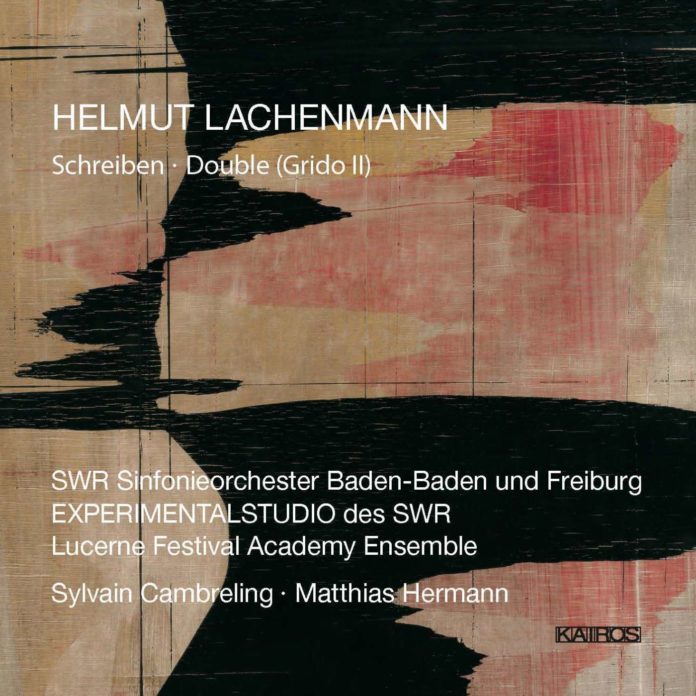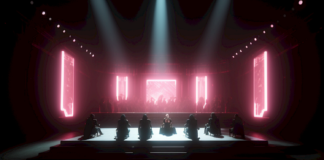Lately someone have complained of Helmut Lachenmann‘s inactivity, interpreting it as an exhaustion of ideas, a lack of will in dealing with the failure of the current contemporary music; the situation is also complicated because of the orchestras’ budget, which leads to a reduced risk of the initiatives and of the costs related to the training of musicians who have to learn the scores in the orchestras: in this sense, the German composer fascinates and frightens at the same time. If we look at his orchestral production, from his first large fresco of Notturno (Musik for Julia) in 1968 up through the two compositions that make up this new CD for the Kairos R., we notice a strong homogeneity of intent and it is quite difficult to find a composition that stands out from the rest, except after repeated listenings. However, beyond the immeasurable stylistic achievement, in the Lachenmann’s wonderful musical world the particular configuration of the sound dynamics is crucial: to support these considerations Schreiben, a composition completed in 2003 and the first orchestral piece that broke the silence after Tableau in 1989, is a master key to get new and brillant textures of amorphous sounds. The recording made in 2006 at MaerzMusik by a very close-knit SWR Sinfonieorchester Baden Baden and Freiburg conducted by Cambreling, with the active help received in the projection of sounds by Michael Acker and the Experimentalstudio des SWR, confirms that the composer has deepened his acoustic observation, also implemented by the possibilities of informatics. A method that tends to the exaltation of microsounds and dynamics.
“Schreiben” leads us strongly into the unclassifiable world of German composer: something that looks like artificial winds (percussion) projecting the listener into a futuristic dimension, namely the animation of objects; but overcoming all doubts and referring to the intrinsic qualities of the piece, Lachenmann underlines that here is the orchestra that “writes”, highlighting the desire to attribute the sounds of writing to the musicians: the instruments simulate writing by trying to find, through the usual unconventional techniques, some sonic similarities with the noises / sounds that can characterize the space of a writer (the paper that moves, the passage of the ink on the paper, the physical aspects of writing, etc.). Is that really subliminal instrumentality?: listening to Schreiben we notice a contrast between the usual defragmented style of Lachenmann and some musical quotations that, as a kind of flash, guide us to Boulez or Ligeti’s orchestras, or to those sporadic musical patterns that stimulate thought to Wagner and Mahler; they are circumstances that reflect the idea that the instruments have even developed a score (namely they write the music) and confirm as the revolutionary, concrete instrumental music has respect for historic paths of the classical music (you think of the building of Air or Notturno, as well as the explicit reference to Mozart in Accanto). Reassemble the pieces in a puzzle of elements apparently without order is a strong capacity of Lachenmann that reveals all his sagacity in the organization of them: in the end, after the hard work of musicians, in Schreiben you’ll end up with the musical situation of the introduction with those “rustles” that conquered many gigs.
If we work by analogy, “Double (Scream II)” theoretically should represent an expressionist situation, painful or distressing, but it does not seem to have that character. That particular emotional condition, that here is amplified and thickened into a group of instrumentation consisting of 48 string instruments, indicates movement and restlessness that lead to the “pain” as the conclusion of a process of a gradual emptying of feelings. The recording made at the Lucerne Festival Academy in 2005 under the direction of Matthias Hermann, makes the idea of an inevitable liberation from suffering, with an extraordinary central part in which acoustic episodes multiply the sound, unleashing an imaginary and mythological concept of “scream”, something that evokes the sufferings and anxieties of the battles of Polyphemus, where there is a radiant mistreatment of stringed instruments that duplicates famous and unknown sounds (because they are obtained with the concrete idea). In the final part, then, a spasmodic silence is broken by the sound power of the stringed instruments that emerge in all their resonance, finally realizing the existential pain of the composition; the last notes are combinations of noises coming from the physical framework of the instruments: a submissive return to normality.
Without any doubt this is the CD of the year in the contemporary music!!
_______________________________________________________________________IT
Negli ultimi tempi qualcuno si lamenta della latitanza compositiva di Helmut Lachenmann, interpretandola come un esaurimento delle idee e della volontà di affrontare il fallimento attuale della musica contemporanea; a complicare la situazione ci si mette anche il budget economico che spinge, anche nei paesi più inclini alla musica contemporanea, ad una riduzione del rischio insuccesso, ma soprattutto dei costi legati alla formazione degli strumentisti che devono imparare le partiture nelle orchestre: in tal senso il tedesco affascina e spaventa al tempo stesso. Se si scorre la sua produzione orchestrale dal suo primo grande affresco di Notturno (Musik for Julia) nel 1968 fino alle due composizioni che compongono questo nuovo cd di Lachenmann per la Kairos R., si nota una forte omogeneità di intenti e risulta alquanto arduo trovare una composizione che possa spiccare rispetto al resto, se non dopo ripetuti ascolti. Tuttavia, aldilà dell’incommensurabile realizzazione stilistica, nell’immaginifico mondo di Lachenmann resta determinante la particolare configurazione delle dinamiche sonore: a supporto di tali considerazioni Schreiben, composizione ultimata nel 2003 e primo pezzo orchestrale che ruppe il silenzio compositivo in materia arenatosi a Tableau del 1989, è un passpartout per ottenere nuove scintillanti tessiture amorfe di suoni. La registrazione effettuata al MaerzMusik 2006 da un’affiatatissima SWR Sinfonieorchester di Baden Baden e Friburgo diretta da Cambreling, con l’aiuto fattivo ricevuto nella proiezione dei suoni da Michael Acker alla regia degli ExperimentalStudio des SWR, conferma come il compositore abbia da tempo impostato l’approfondimento verso l’osservazione acustica retta anche dalle possibilità informatiche. Un metodo che tende all’esaltazione dei microsuoni e delle dinamiche.
“Schreiben” ci scaraventa subito nel mondo inclassificabile del compositore tedesco: qualcosa che assomiglia a venti percussivi artificiali proietta l’ascoltatore in una dimensione futuristica, quella dell’animazione degli oggetti; ma sgombrando ogni dubbio e riferendosi alle qualità intrinseche del pezzo Lachenmann sottolinea che qui è l’orchestra che “scrive”, evidenziando la volontà di attribuire un fare all’opera dei musicisti: gli strumenti simulano la scrittura cercando di trovare, attraverso la consueta anti-convenzionalità delle tecniche, analogie sonore con i rumori/suoni che possono caratterizzare lo spazio di uno scrivano (fogli che si muovono, passaggio dell’inchiostro sul foglio, modalità fisiche della scrittura, etc.) C’è realmente questo stato di subliminalità strumentale?: in verità l’ascolto di Schreiben restituisce una contrapposizione tra l’usuale stile deframmentato di Lachenmann e le citazioni musicali che, a mò di flash, interessano il Boulez o Ligeti orchestrale, o quei sporadici patterns musicali che stimolano il pensiero a Wagner e Mahler: sono circostanze che se da una parte provocano l’idea che gli strumenti stanno persino realizzando una partitura (la stanno proprio scrivendo), dall’altra confermano come la sua rivoluzionaria musica concreta strumentale abbia rispetto per i percorsi sostanziali della storicità classica (si pensi al nuovo riempimento formale che scorreva in Air o Notturno, nonché all’esplicito riferimento a Mozart in Accanto). Ricomporre i tasselli in un puzzle apparentemente scordinato di elementi è una delle armi vincenti di Lachenmann e rivela tutta la sua sagacia organizzativa: alla fine, dopo duro lavoro dei musicisti, in Schreiben ci si ritroverà con la situazione musicale di partenza, con quei “fruscii” che hanno conquistato molti palcoscenici.
Lavorando per analogia “Double (Grido II)” teoricamente dovrebbe segnalare una situazione espressionista, dolorosa o penosa, ma non pare avere quei caratteri. Quella particolare condizione emotiva che qui viene amplificata ed ispessita nella strumentazione formata da un amplesso di 48 strumenti a corda, segnala movimento ed inquietudine che conducono al “grido” come conclusione di un processo di graduale svuotamento dei sentimenti. La registrazione effettuata al Lucerna Festival Academy 2005 con la direzione di Matthias Hermann, rende l’idea di un’inevitabile liberazione dell’insofferenza, con una parte centrale straordinaria in cui gli episodi acustici si moltiplicano scatenando nell’immaginario un concetto di grido mitologico, qualcosa che evoca le sofferenze e le ansie delle battaglie di Polifemo, ove si assiste ad un radioso maltrattamento degli strumenti a corda che “duplicano” suoni conosciuti e sconosciuti (perché ottenuti con l’idea concreta). Nella parte finale, poi un silenzio spasmodico viene rotto dalla potenza acustica degli strumenti a corda che emergono in tutta la loro risonanza, realizzando finalmente quel dolore esistenziale su cui probabilmente la composizione si basa, lasciando le ultime note all’impianto fisico dei rumori provenienti dalla cassa degli strumenti: un remissivo ritorno alla normalità.
Senza nessun dubbio questo è il cd dell’anno nel settore della contemporanea!!







